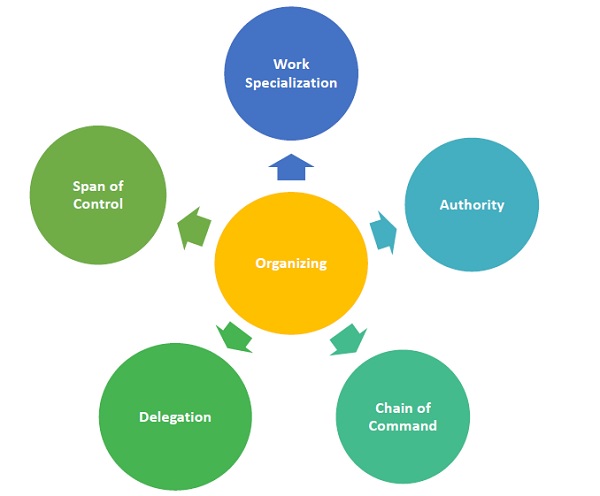
- Management Principles - Home
- Management - Overview
- Management - Role Of Managers
- The P-O-L-C Framework
- Management - Ecosystem
- Management - Environment
- Management - Factors Affecting
- Management - Organization
- Management - Leadership Styles
- Management - Framework
- Mission,Vision and Values
- Personalty and Attitude
- Work Attitude and Behaviour
- Decision Making
- Decision Making Nature Significance
- Factors Affecting Decision Making
- Decision Making - Styles
- Decision Making - Tools
- Management - Planning
- Planning - Introduction
- Types Of Plans
- The Planning Environment
- Organizational Structure
- Importance Of Organizing
- Principles Of Organizing
- Organizational Structure
- Organizational Process
- Change Management
- Organizational Change
- Organizational Change Factors
- Organizational Change Management
- Globalization and Its Effect
- Multinational Organizations
- Global Ecosystem and its Impact
- Management Useful Resources
- Management - Quick Guide
- Management - Useful Resources
- Management - Discussion
Management Principles of Organizing
The following illustration shows the five principles of Organizing −

Work Specialization
Also called division of labor, work specialization is the degree to which organizational tasks are divided into separate jobs. Each employee is trained to perform specific tasks related to their specialized function.
Specialization is extensive, for example running a particular machine in a factory assembly line. The groups are structured based on similar skills. Activities or jobs tend to be small, but workers can perform them efficiently as they are specialized in it.
In spite of the obvious benefits of specialization, many organizations are moving away from this principle as too much specialization isolates employees and narrows down their skills to perform routine tasks.
Also it makes the organization people dependent. Hence organizations are creating and expanding job processes to reduce dependency on particular skills in employees and are facilitating job rotation among them.
Authority
Authority is the legitimate power assigned to a manager to make decisions, issue orders, and allocate resources on behalf of the organization to achieve organizational objectives.
Authority is within the framework of the organization structure and is an essential part of the managers job role. Authority follows a top-down hierarchy. Roles or positions at the top of the hierarchy are vested with more formal authority than are positions at the bottom.
The extent and level of authority is defined by the job role of the manager. Subordinates comply with the managers authority as it is a formal and legitimate right to issue orders.
Chain of Command
The chain of command is an important concept to build a robust organization structure. It is the unbroken line of authority that ultimately links each individual with the top organizational position through a managerial position at each successive layer in between.
It is an effective business tool to maintain order and assign accountability even in the most casual working environments. A chain of command is established so that everyone knows whom they should report to and what responsibilities are expected at their level. A chain of command enforces responsibility and accountability. It is based on the two principles of Unity of command and Scalar Principle.
Unity of command states that an employee should have one and only one manager or supervisor or reporting authority to whom he is directly accountable to. This is done to ensure that the employee does not receive conflicting demands or priorities from several supervisors at once, placing him in a confused situation.
However, there are exceptions to the chain of command under special circumstances for specific tasks if required. But for the most part organizations to a large extent should adhere to this principle for effective outcomes.
Scalar principle states that there should exist a clear line of authority from the position of ultimate authority at the top to every individual in the organization, linking all the managers at all the levels. It involves a concept called a gang plank
using which a subordinate may contact a superior or his superior in case of an emergency, defying the hierarchy of control. However, the immediate superiors must be informed about the matter.
Delegation
Another important concept closely related to authority is delegation. It is the practice of turning over work-related tasks and/or authority to employees or subordinates. Without delegation, managers do all the work themselves and underutilize their workers. The ability to delegate is crucial to managerial success.
Authority is said to be delegated when discretion is vested in a subordinate by a superior. Delegation is the downward transfer of authority from a manager to a subordinate. Superiors or managers cannot delegate authority they do not have, however, high they may be in the organizational hierarchy.
Delegation as a process involves establishment of expected outcomes, task assignment, delegation of authority for accomplishing these tasks, and exaction of responsibility for their accomplishment. Delegation leads to empowerment, as employees have the freedom to contribute ideas and do their jobs in the best possible ways.
Span of Control
Span of control (also referred to as Span of Management) refers to the number of employees who report to one manager. It is the number of direct reportees that a manager has and whose results he is accountable for.
Span of control is critical in understanding organizational design and the group dynamics operating within an organization. Span of control may change from one department to another within the same organization.
The span may be wide or narrow. A wide span of control exists when a manager has a large number of employees reporting to him. Such a structure provides more autonomy. A narrow span of control exists when the number of direct reportees that a manager has is small. Narrow spans allow managers to have more time with direct reports, and they tend to spark professional growth and advancement.